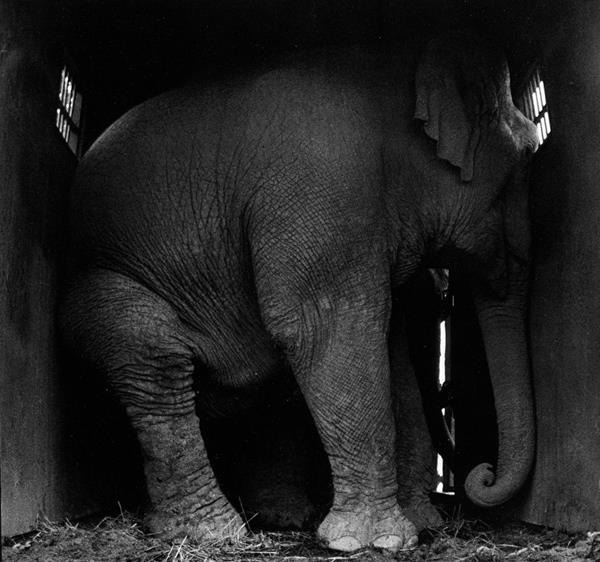 Reasons to Go Vegan #10: Animal Acts
Reasons to Go Vegan #10: Animal Acts
 Cruelty in Circuses, Rodeos and Whale and Dolphin Shows
Cruelty in Circuses, Rodeos and Whale and Dolphin Shows
 Whenever people say "We mustn't be sentimental," you can take it they are about to do something cruel. And if they add "We must be realistic," they mean they are going to make money out of it.
Whenever people say "We mustn't be sentimental," you can take it they are about to do something cruel. And if they add "We must be realistic," they mean they are going to make money out of it.
—Brigid Brophy
Intro |
Rodeo |
Circus |
Zoos |
Ocean Animals |
Greyhounds |
Cock Fighting |
Carriage Horses |
Horse Racing
INTRO
Circuses enslave their animals forcing them to perform under duress with cruel and unusual punishments.
What makes a bronco buck like that? Electric prods, cutting spurs on the entirety of their flanks and claustrophobic confinement are but a few of the unacceptable practices at rodeos.
 Orcas are the only whale group that don't follow regular migratory patterns preferring to roam the wide oceans at will. To confine them permanently in pens the size of a single-family residence and forcing them to "perform" 3-8 times a day, 24/7, is beyond cruelty and completely unacceptable treatment of a living creature, and all in the name of profit.
Orcas are the only whale group that don't follow regular migratory patterns preferring to roam the wide oceans at will. To confine them permanently in pens the size of a single-family residence and forcing them to "perform" 3-8 times a day, 24/7, is beyond cruelty and completely unacceptable treatment of a living creature, and all in the name of profit.
Casino cat shows, no matter how loving the performer/owners purport to be, are a disgrace to those of us who call ourselves humane.
To witness animal cruelty for yourself or for in-depth information to share with others visit, "The Saddest Show on Earth", SHARK'S (SHowing Animals Respect & Kindness) Rodeo Cruelty site, and view the movie and activist site, A Fall From Freedom, the untold story behind the captive whale and dolphin industry.
RODEOS
-
Rodeos, PeTA
In rodeo events, such as calf roping, steer wrestling, bareback horse and bull riding, saddle bronc riding, steer wrestling, steer roping, and barrel racing, normally docile animals are physically provoked into displaying "wild" behavior in order to make the cowboys look brave.
Electric prods, spurs, and bucking straps are used to irritate and enrage animals used in rodeos. Before entering the ring, cows and horses are often prodded with an electrical "hotshot" so that the pain will rile them. More… -
Rodeo Cruelty, SHARK: Showing Animals Respect and Kindness
Forget the myth of rodeos as all-American sport. Modern rodeos are cruel and deadly for animals. Traditional ranch work has been perverted into a spectacle of animal abuse disguised as "western tradition." Today's rodeos bear little resemblance to ranch work where care was taken to not injure animals. Modern rodeos are nothing more than western-themed circuses with contestants wearing John Wayne costumes and racing against the clock in a cruel spectacle for cash prizes all to sell sugar water, alcohol, and automobiles to the fans. And it's the animals who pay the price, from being electrically prodded to make horses and bulls appear wild to the countless injuries animals suffer from contestants who only care about beating the clock and winning cash before moving on to the next rodeo in the next city.
Anyone with a heart knows it's wrong to clothesline a baby animal, body slam it to the ground, tie its legs so it can?t move, and drag it by the neck. If this were done to a puppy or kitten, the offender would understandably be charged with a crime, and likely be jailed. In rodeos, however, it's called calf roping, and supporters claim it?s a sport. But the abuse of baby cows is just one of rodeo?s cruelties. Read further and watch some of SHARK's video proof from years of rodeo investigations. More…
THE RODEO
—Michael J Ahles
Photos: SHARK
SHowing Animals Respect and Kindness
 If rodeo cowboys could be rodeo animals for only one day,
If rodeo cowboys could be rodeo animals for only one day,And be:
Broken and bridled, saddled and spurred,
Caged and corralled,
Scared, frightened, to bolt and run,
Chased, lassoed and stretched,
Hog tied and wrestled to the ground,
And by whatever means made to
 Jump, buck, turn and kick,
Jump, buck, turn and kick,To be slaughtered someday,
Charbroiled and eaten as a steak;
Why Sonny I'll bet ya two bits,
The rodeo would be no more.
Then rather than a wave of a cowboy hat,
And a Yee ha, Yippity yi yeah!
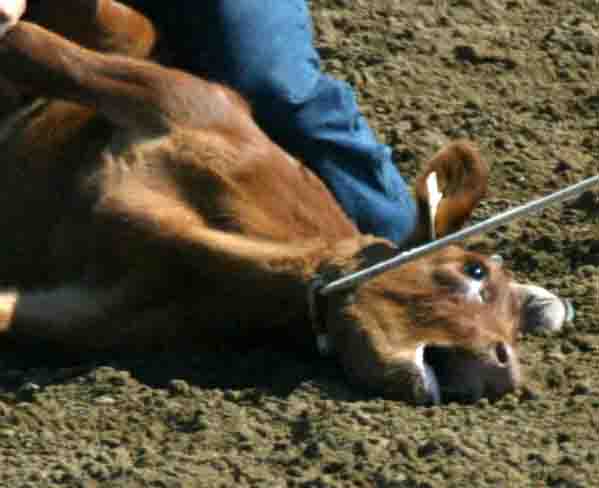 There would only be a quiet whinny,
There would only be a quiet whinny,The soft cry of moo hoo hoo,
And a wag of many tails.
—Michael J Ahles
Photos: SHARK
SHowing Animals Respect and Kindness


Why did this happen? See the treatment of elephants by circus staff in this video. If you want to skip the footage of Tyke on his last day, start the video at 1:30 to see the kind of treatment from which he fled.
| Spot the happy elephants. | ||
|---|---|---|

Life = Good |
|
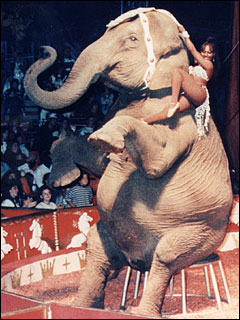
Trainers claim they break the spirit of elephants to get them to perform. |
Raw footage of circus animal training. Before you go to a circus or rodeo again take a look at what is going on behind the scenes.
"I did research on my own and it was worse than what PeTA had told me. I was not animal rights at the time."
"I did research on my own and it was worse than what PeTA had told me. I was not animal rights at the time."
To get involved with ending animal cruelty, please see our Animal Rights page.
-
El Salvador votes to ban wild animals in circuses, ADI, 8/2013
El Salvador has become the latest Latin American country to progress legislation to ban wild animals in circuses, under the reform of its wildlife conservation law which was passed on Friday.
Under Article 20 of the revised legislation, any show featuring wild animals will be prohibited. More… -
Elephant debate roils Nevada County fair, Sacramento Bee, 8/2013
 The battle lines are drawn this week at the Nevada County Fair, where animal activists have converged to protest the elephant rides featured as part of this year's "Under The Big Top" theme.
The battle lines are drawn this week at the Nevada County Fair, where animal activists have converged to protest the elephant rides featured as part of this year's "Under The Big Top" theme.
More than 100 people, some dressed in elephant costumes, protested the rides Wednesday evening near the fair's main gate, drawing honks of support and shouts of derision from motorists. Outside ticket booths Thursday, activists passed out fliers and tried to convince fairgoers to forgo the rides.
At the center of the controversy is an incendiary undercover video of elephant trainers for Have Trunk Will Travel, which brought Rosie and her elephant companion, Becky, to Grass Valley. The video, which the company claims is heavily edited and misleading, shows trainers repeatedly striking elephants with titanium poles in an effort to get them to lay down and obey other commands.
The dust-up in bucolic Grass Valley reflects a growing debate about wild animals and their interactions with humans.
Once a staple of fairs and carnivals across the country, elephant rides are fading from the landscape. No other venue in Northern California has featured them in years, said Ed Stewart, whose PAWS sanctuary in Calaveras County allows rescued elephants to roam freely. The Santa Ana Zoo and the Orange County fair, among other venues, recently stopped offering elephant rides. More… -
Colombia says 'no mas' to wild animals used in circuses, 6, 2013
 After a six-year public campaign that included scientific reviews and exposed extreme abuse of circus animals through undercover investigations, Colombia joined four other South American countries (Peru, Bolivia, Ecuador and Paraguay) to ban their use. More…
After a six-year public campaign that included scientific reviews and exposed extreme abuse of circus animals through undercover investigations, Colombia joined four other South American countries (Peru, Bolivia, Ecuador and Paraguay) to ban their use. More…
Solutions
-
No Elephants at the Nevada County Fair,
A quick google search of HTWT reveals rampant and cruel training methods used by the owners Kari and Gary Johnson and their employees against their elephants ? the same ones used in the movie ?Water for Elephants? where these abusive techniques came to light. Undercover video shot by Animal Defenders International (ADI) shows liberal use of stun guns and bull hooks ? even on a baby elephant who cries in pain as the hook is jabbed into her mouth.
Many fairs around the state of California have cancelled elephant rides because of obvious abuse and safety issues (HTWT was cited by the USDA in August of 2012 for violating the federal Animal Welfare Act by failing to safely supervise the elephants during an appearance in Rapid City, South Dakota.) More… - Elephants are NOT Circus Performers, Care2 petition.
- Punish Circus for Abusing an Elderly Elephant!, Care2 Petition
- Ban the Use of Wild Animals in US Circuses, Care2 Petition
- Ban All Circuses That Involve Animals, Care2 Petition
- Sign Here to Stop Circus Cruelty!, PeTA



ZOOS
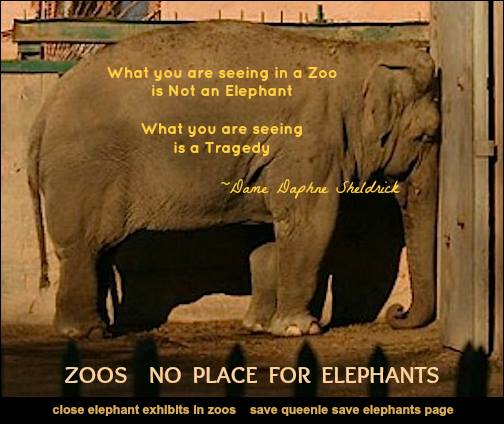
Articles
Solutions
OCEAN ANIMAL ACTS

Articles
-
Costa Rica will close zoos and release animals to nature, NewEurope, 8/2013
Costa Rica, known for its animal diversity, wants to provoke a change of environmental conscience among its inhabitants. The main leader of this activity is the Environment Minister René Castro.
"We are getting rid of the cages and reinforcing the idea of interacting with biodiversity in botanical parks in a natural way," Castro said for Treehugger. "We don't want animals in captivity or enclosed in any way unless it is to rescue or save them." More… -
Elephants dying out in zoos, Seattle Times, 12/2012
Zoos' efforts to preserve and propagate elephants have largely failed, both in Seattle and nationally. The infant-mortality rate for elephants in zoos is almost triple the rate in the wild.
The public seemed to feel a unique connection to elephants, gentle giants who exhibit many humanlike qualities. Elephants live in families, exhibit memory and possess surprising self-awareness, such as recognizing themselves in a mirror. They experience grief and love, pain and fear.
It was clear that elephants, the world's largest land mammals, were indeed "glamour beasts," box-office stars that would help America's zoos through the 20th century and into the 21st. Across the country, the race to produce baby elephants was on.
Fifty years later, The Seattle Times set out to examine how that effort has turned out. Despite the zoo industry's insistence otherwise, by almost any measure, it has failed. More… -
Elephant havens face zoo-industry backlash, Seattle Times, 1/2013
American zoos face swift and harsh punishment when they retire their aged elephants to a 2,300-acre sanctuary in the California foothills.
After decades of captivity inside America's zoos, the elephants arrived broken in many different ways.
Maggie barely survived the harsh winters of the tiny Alaska Zoo. Confined many days to a cramped, indoor pen, she developed crippling foot and joint disease, collapsing to the floor — lifted only by a crane. Zookeepers conceded that frigid Anchorage was no place for a 4-ton tropical beast.
Annie spent much of her life in chains at the Milwaukee County Zoo until the public learned of brutal training sessions. Zookeepers routinely anchored the elephant's feet with chains, then struck and gouged her with a bullhook, even videotaping sessions to teach others how to make an elephant perform on command.
And there is Wanda, whose cracked feet and arthritic legs deteriorated with each bitter winter at the Detroit Zoo. Its officials concluded that captivity was unnecessarily cruel for the world's largest land mammal.
The three elephants now share a different life at a 2,300-acre compound nestled in the San Andreas foothills. Pat Derby, co-founder of the nonprofit sanctuary, says, "This is where elephants come to die." More…

"Hansa, who in 2000 became the only elephant born at Seattle's Woodland Park Zoo, plays with her mom, Chai, in October 2001. Hansa died at 6½ years old, the victim of a virus that had been killing young elephants at U.S. zoos." Photo: BENJAMIN BENSCHNEIDER / THE SEATTLE TIMES
Solutions
-
Save Queenie The Elephant Facebook Page.
Save one elephant, save all. We are the voice for elephants in poor conditions in circuses & zoos, and for the dangers to them as they near extinction due to poaching.
Mission
We advocate for one elephant and for the whole species, especially with the rampant slaughter in Africa due to poaching. "Never, never be afraid to do what is right, especially if the well-being of a person or animal is at stake. Society's punishments are small compared to the wounds we inflict on our soul when we look the other way." MLK More… -
Zoos: Is it Time to Close America's Zoos?, Psychology Today, 8/2013
More…
Ocean Animal Acts confine orcas, the only whale in the waters that don't have a specific migrating pattern but swim at will thoughout the vast ocean, to 20x40x30' pens.


-
Marine Animal Exhibits: Chlorinated Prisons, PeTA
At aquariums around the country, orcas leap through the air for a handful of fish and are ridden by human performers as if they were water skis. Tourists flock to facilities that offer them the opportunity to swim or have their pictures taken with dolphins. These parks and zoos are part of a billion-dollar business built on the suffering of intelligent, social beings who are denied everything that is natural and important to them. Ric O'Barry, who was a dolphin trainer for the Flipper television series in the 1960s, says that parks and zoos "want you to think that God put [dolphins] there or [that] they rescued them. … If people knew the truth, they wouldn't buy a ticket." More…
-
Sea World of Hurt, Where Happiness Tanks.
SeaWorld enslaves and confines animals to small tanks at marine parks around the country, where they are forced to perform unnecessary tricks for "entertainment." Animals imprisoned at SeaWorld often die prematurely from stress and other captivity-related causes, but you can help them today. Explore this site, learn more, and refuse to buy tickets to SeaWorld. More…
-
"Shamu" Kills Trainer--Killer Whale's Act Not Normal, National Georgraphic, 2/2010
Perryman points out that other captive animals are known to snap and turn on their trainers—not just killer whales.
"I think this isn't really a killer whale issue," he said. "It's when you're dealing with large mammals in a captive situation.
"It doesn't make a difference whether its elephants or bears or whatever. These kinds of things can happen." More… -
Dolphins gain unprecedented protection in India, Deutsche Welt, 5/2013
 India has officially recognized dolphins as non-human persons, whose rights to life and liberty must be respected. Dolphin parks that were being built across the country will instead be shut down.
India has officially recognized dolphins as non-human persons, whose rights to life and liberty must be respected. Dolphin parks that were being built across the country will instead be shut down.
India's Ministry of Environment and Forests has advised state governments to ban dolphinariums and other commercial entertainment that involves the capture and confinement of cetacean species such as orcas and bottlenose dolphins. In a statement, the government said research had clearly established cetaceans are highly intelligent and sensitive, and that dolphins "should be seen as 'non-human persons' and as such should have their own specific rights."
The move comes after weeks of protest against a dolphin park in the state of Kerala and several other marine mammal entertainment facilities which were to be built this year. Animal welfare advocates welcomed the decision.
"The scientific evidence we provided during the campaign talked about cetacean intelligence and introduced the concept of non-human persons," she said in an interview with DW.
Indiais the fourth country in the world to ban the capture and import of cetaceans for the purpose of commercial entertainment - along with Costa Rica, Hungary, and Chile.
Dolphins are persons, not performers
The movement to recognize whale and dolphins as individuals with self-awareness and a set of rights gained momentum three years ago in Helsinki, Finland when scientists and ethicists drafted a Declaration of Rights for Cetaceans. "We affirm that all cetaceans as persons have the right to life, liberty and well-being," they wrote. More… -
Killer whales at Seaworld had teeth removed with power drills and were left to mourn on own after being separated from young, The Daily Mail, UK, 7/2012
Brutally butchered in February 2010 by a killer whale named Tilikum, the book states that such an event was inevitable and that these kinds of tragic occurrences will continue if the animals continue to be treated in the same way.
Written by New York City reporter David Kirby, 'Death at SeaWorld' claims that killer whales kept in captivity suffer immense emotional and psychological trauma and spoke to former trainers and campaigning animal rights advocates to present his damning case. Staff interviewed by Kirby told him of killer whales destroying their teeth on metal gates and then subsequently having those teeth removed by staff wielding power drills. More…
Ocean Animal Act Solutions
- What You Can Do to Help Oceans and Ocean Animals Easy ways to make a difference, Humane Society US., 3/12.
- Why Is SeaWorld Allowing Its Killer Whales to Live in Crumbling Pools?, Take Part, 3/2013
-
The Orca Project - SeaWorld
The Orca Project Corp is a small but effective 501(c)(3) non-profit corporation, collaborating with some of the world's top marine mammal experts and caring professionals from diverse backgrounds, working to change the public's attitude and government supervision of marine mammals in captivity through research, investigation and education. We are committed to providing the public with a look behind the scenes of the marine mammal captivity/entertainment industry, explore the legal and ethical issues of keeping orcas in captivity and to keep pressure on our government oversight agencies to enforce and improve animal welfare regulations.
Greyhound Dog Racing
-
Greyhound Racing FAQ, ASPCA

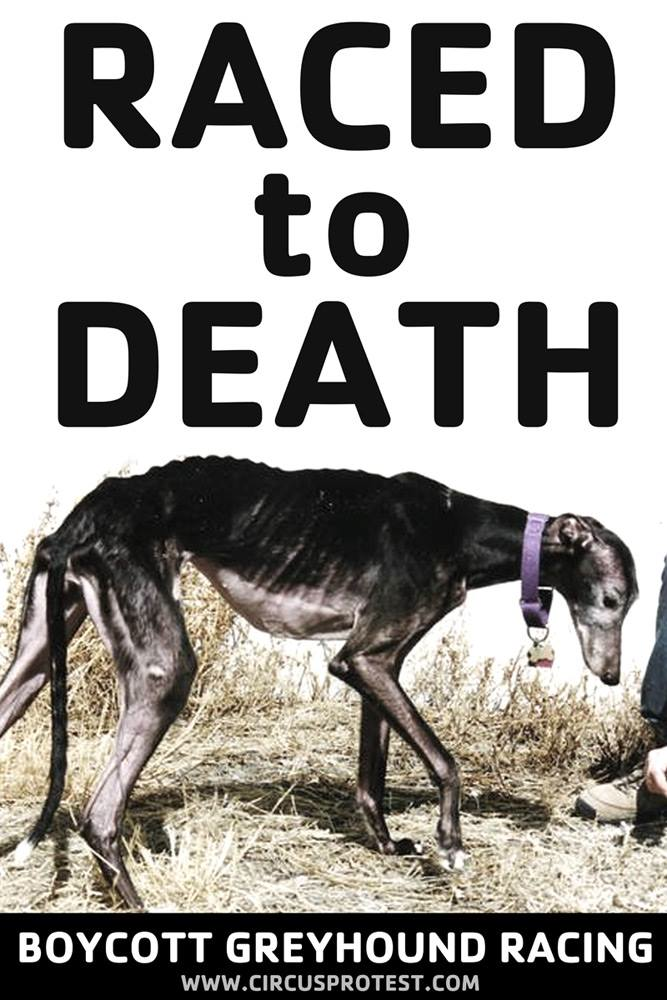 Greyhound racing may seem like a harmless sport, but life in the fast lane is no picnic for these overworked dogs. Every year, thousands of young and healthy Greyhounds are killed merely because they lack racing potential, are injured while racing or are no longer competitive. Life is hard for those who make the grade—they spend long hours in cramped kennels and are deprived of normal social contact and life experiences. While people are becoming more aware of the horror of this sport, there are still more than 20 tracks operating in the U.S. and one just over the border in Juarez, Mexico.
Greyhound racing may seem like a harmless sport, but life in the fast lane is no picnic for these overworked dogs. Every year, thousands of young and healthy Greyhounds are killed merely because they lack racing potential, are injured while racing or are no longer competitive. Life is hard for those who make the grade—they spend long hours in cramped kennels and are deprived of normal social contact and life experiences. While people are becoming more aware of the horror of this sport, there are still more than 20 tracks operating in the U.S. and one just over the border in Juarez, Mexico.
There are many ways you can help end the Greyhound racing industry:- Do not attend Greyhound races.
- Educate family and friends about the animal welfare problems and safety concerns related to Greyhound races.
- Consider adopting a retired greyhound and encourage people you know to do the same. Greyhounds make wonderful family pets, and adoption events are held all over. The dogs can also be found at rescues and shelters.
- Take a more active role in helping to end Greyhound racing by working with the ASPCA to pass legislation that prohibits it. Stay up-to-date about current legislation to ban Greyhound racing by joining the ASPCA Advocacy Brigade. More…
-
Bullfighting, Dog Fighting, Cockfighting Banned In Veracruz, Mexico, Opposing Views, 7/2013
Veracruz has become the most recent city in Mexico to update its Animal Welfare Code to ban bullfighting. The government of Veracruz — a port city about 186 miles east of Mexico City —joined four other cities — Xalapa, Fortin de las Flores, Teocelo and Boca de Rio — all located in Veracruz state, in passing a ban on bullfighting. A comprehensive change to the Animal Welfare Code by Veracruz city lawmakers last month, however, included banning "bullfighting and all other shows featuring animals."
The city will now also address other blood sports that have long been accepted, and this new legislation will end the traditional festivals that offered animal fighting as entertainment.
"Officials changed the Animal Welfare Code to ban bullfights, dog fights and cockfights," said Veracruz Mayor Carolina Gudiño Corro. "The new regulations were enacted to prevent abuse of pets and other animals by owners and the public and create a culture of caring for animals." More…
Cock Fighting
-
Cockfighting
 Cockfighting—a blood sport in which two roosters specifically bred for aggressiveness are placed beak to beak in a small ring and encouraged to fight to the death—has been around for centuries. Roosters were first bred for fighting in Southeast Asia more than 3,000 years ago, and cockfighting later spread to Greece, Rome and Britain before crossing the Atlantic about 200 years ago. The brutal ?sport" found popularity in North, South and Central Americas, and was particularly prevalent in Colonial New York, Philadelphia and Boston. By the 1800s, it had spread to the South and West Coast—but by this time, people had begun to realize how cruel it was, and many states banned it. Today, cockfighting is a crime in all 50 states and the District of Columbia. Yet, despite these laws, cockfighting still persists. More…
Cockfighting—a blood sport in which two roosters specifically bred for aggressiveness are placed beak to beak in a small ring and encouraged to fight to the death—has been around for centuries. Roosters were first bred for fighting in Southeast Asia more than 3,000 years ago, and cockfighting later spread to Greece, Rome and Britain before crossing the Atlantic about 200 years ago. The brutal ?sport" found popularity in North, South and Central Americas, and was particularly prevalent in Colonial New York, Philadelphia and Boston. By the 1800s, it had spread to the South and West Coast—but by this time, people had begun to realize how cruel it was, and many states banned it. Today, cockfighting is a crime in all 50 states and the District of Columbia. Yet, despite these laws, cockfighting still persists. More…
Carriage Horses
-
Both Reno and Las Vegas have outlawed horse-drawn carriages, but they may be seen nearby in South Lake Tahoe.
On this day in August, 2012, a horse was seen favoring a tender foot but set to work in any case. On another occasion, a single horse was seen to strain under the weight of pulling 8 adults in the oversized, three-bench carriages and faltered on the cobblestones.Carriage Horses. The carriage horse industry has been banned in many major European cities. The reasons vary, but most commonly cited are:
- Horses spending hours breathing in heavy exhaust fumes
- risk of serious injury or death in a traffic accident
- poor or inadequate stabling,
- little care or no veterinary care,
- poor hoof care
- a life of drudgery, boredom, overwork and depression
- forced to endure extreme outdoor temperatures and weather conditions.
- limited, if any, access to water
 City officials became convinced, because of a steady stream of complaints from concerned citizens and tourists, that the lives of carriage horses were indeed abysmal, and they could not improve their lives, no matter how much the trade is regulated. More…
City officials became convinced, because of a steady stream of complaints from concerned citizens and tourists, that the lives of carriage horses were indeed abysmal, and they could not improve their lives, no matter how much the trade is regulated. More…
Articles
- Update: Jerry the Horse Revealed Dead After Cover-Up
- Imposter! PETA offers $1,000 reward for whereabouts of Jerry the carriage horse after his owners try to pass off a photo of another animal as the injured mare
13-year-old Jerry collapsed earlier this month due to a bout of colic More than a week after Jerry the carriage horse collapsed in Salt Lake City, PETA is offering a reward of up to $1,000 for information leading to his whereabouts.
More than a week after Jerry the carriage horse collapsed in Salt Lake City, PETA is offering a reward of up to $1,000 for information leading to his whereabouts.
The 13-year-old dapple-gray half-Thoroughbred/half-Percheron horse collapsed while pulling a carriage through downtown traffic in sweltering heat.
Jerry was left lying for several hours on the scorching pavement, before his owners eventually moved him via forklift to a nearby stable.
In response to concerns about Jerry?s recovery, Annette Overson, who co-owns Carriage for Hire, the company that carries out the rides, provided The Salt Lake Tribune with a photo that she claimed was Jerry standing up in a stable.
Overson has since admitted to Mailonline that she had tried to pass off another horse as Jerry and described her actions as 'stupid?.
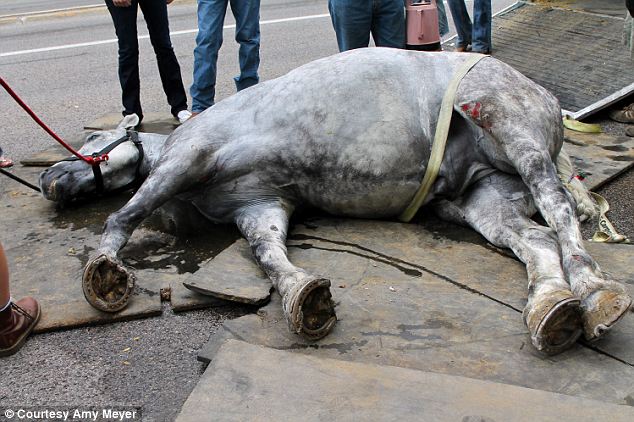 Now PETA are offering a reward of up to $1,000 for information leading to the whereabouts of Jerry.
Now PETA are offering a reward of up to $1,000 for information leading to the whereabouts of Jerry.
'We fear that Jerry may have become another victim of the cruel horse-carriage trade.'
Jerry was near the end of a tour when he suddenly kicked his stomach and collapsed to the ground on August 17.
'It was distressing because lots of people there wanted to do something, but didn?t know what to do,? Schulthies said. 'Obviously, the carriage company didn?t have any plan for that type of thing.?
'After reviewing the video footage of the incident and consulting with equine experts and veterinarians, we question the diagnosis of colic and subsequent reports from Carriage for Hire,' More… -
Young girl injured in runaway horse-and-carriage accident injured in runaway horse-and-carriage accident, KTVU, 8/2013
An 11-year-old girl and a man riding in a horse-drawn carriage were injured in a collision near Petaluma Saturday, police said.
This morning, 63-year-old Pleasanton man James Crawford and his horse "Lady" were providing horse-drawn carriage rides at a family event at a home on East Washington Street, according to police.
Around noon, an 11-year-old Cotati girl was riding in the carriage on East Washington Street when the horse became spooked and took off running at full speed. Police said Crawford tried unsuccessfully to stop his horse, which steered into a city traffic sign, causing the man to be ejected.
Crawford tried to hold onto the reins of the carriage and was dragged for several yards before losing his grip.
Meanwhile, 58-year-old Petaluma resident Martin Sessi was driving eastbound on East Washington Street when he saw Crawford get ejected from the runaway carriage, according to police. More… -
NY carriage crashes, horse flees up Broadway, CNN, 8/2012
 It wouldn't be shocking to see cats or lions on Broadway. Many have flocked to Broadway to see these animals, in plays of course.
It wouldn't be shocking to see cats or lions on Broadway. Many have flocked to Broadway to see these animals, in plays of course.
But how about a horse running down Broadway dodging Manhattan traffic while dragging terrified tourists?
That's what happened Thursday afternoon in a horse-drawn carriage accident that had even the most hard-to-startle New Yorkers gawking.
"The horse got spooked and rolled the carriage," NYPD Detective Martin Speechley said. "There were two passengers and a driver. All of them have nothing but minor injuries, if there are any injuries at all."
Witnesses said the horse was moving westward along Central Park South when it entered Columbus Circle, a traffic rotary at the park's southwest corner, and bolted. As it ran, it struck an object, which split the carriage in two parts and freed the horse to run free, they said.
"I saw the horse at a full gallop with either people or a person in the carriage," said CNN's Soledad O'Brien, who watched the incident unfold in front of the network's New York bureau. "Then the carriage separated and the horse ran up Broadway."More… -
Midtown Accident Reignites Horse-Drawn Carriage Debate, CBS, New York, 8/2012
 But critics said the accident proves that the law must change. Scott Levenson of New Yorkers for Clean, Livable and Safe Streets said he wants the city to say "neigh" and ban horse-drawn carriages.
But critics said the accident proves that the law must change. Scott Levenson of New Yorkers for Clean, Livable and Safe Streets said he wants the city to say "neigh" and ban horse-drawn carriages.
"This is the 13the accident over the last 12 months. It's not a question of if something's going to happen in this industry; it's just a question of when," Levenson told CBS 2's Kramer.
"It's inhumane treatment to the animal and a huge danger to the area," State Sen. Tony Avella said.
 "The horse-drawn carriage industry is inherently dangerous," said Assemblymember Linda Rosenthal. "Despite claiming to have taken every available precaution, the industry cannot ensure the basic safety of the horses or the public."
"The horse-drawn carriage industry is inherently dangerous," said Assemblymember Linda Rosenthal. "Despite claiming to have taken every available precaution, the industry cannot ensure the basic safety of the horses or the public."
Rosenthal is renewing her call for passage of a bill she introduced in June 2011 that would ban horse-drawn carriages in New York and require humane relocation of the horses released from service.
Thursday's accident apparently did little to scare tourists away from taking carriage rides. It was as busy as ever around Central Park on Friday, but it's clear that this is one municipal debate that is not going away any time soon. More…


Resources, News, Solutions
- The Cruelty Of Horse Drawn Carriages, PeTA
- Horses Without Carriages International
- Animal rights group wants to ban carriage horses in Old Sacramento
- Coalition to Ban Horse-Drawn Carriages
Horse Racing
-
Fact Sheet: Transport to Slaughter, VEW
It is the united opinion of the Veterinarians for Equine Welfare (VEW) that opponents of legislation currently before the United States Congress that would end horse slaughter and prohibit export of horses for slaughter, have been misleading when stating that horses being transported to slaughter are well-protected by existing federal regulations. This clearly is not the case and the links below provide graphic examples of the condition of slaughter-bound horses during transport. More…
The brutal truth behind horse auctions and the journey to slaughter
Articles
-
Two-Year-Old Filly Dies in Saratoga. Count For Track is 8, Horseracing Wrongs, 9/2013
 In addition to Sarava's Dancer, Kris Royal, and Saginaw, a two-year-old filly named Ocean Breeze also broke down and died last week in Saratoga. But because the child-horse was only training, attention was noticeably lacking. Still, I believe the Times Union, as a racing apologist, was being less than truthful when it called Saginaw's "the fifth race day death of the Saratoga meet." Technically correct, but were not Black Rhino, Ricochet Court, and Ocean Breeze also Thoroughbred "athletes" who perished at the Saratoga Race Course? The 2013 Death Count stands at 8. More…
In addition to Sarava's Dancer, Kris Royal, and Saginaw, a two-year-old filly named Ocean Breeze also broke down and died last week in Saratoga. But because the child-horse was only training, attention was noticeably lacking. Still, I believe the Times Union, as a racing apologist, was being less than truthful when it called Saginaw's "the fifth race day death of the Saratoga meet." Technically correct, but were not Black Rhino, Ricochet Court, and Ocean Breeze also Thoroughbred "athletes" who perished at the Saratoga Race Course? The 2013 Death Count stands at 8. More…
Resources / Action
-
Veterinarians for Equine Welfare (VEW)
The website is a forum to inform other veterinarians, horse owners, politicians and the American public about the truth behind horse slaughter. More…
-
Horse Racing Wrongs
 Dedicated to exposing the underlying wrongs that engulf horseracing: the rush to track, where colts and fillies are forced to run on physically immature bodies; the pervasive and largely unchecked doping, legal and otherwise; the unconscionable breakdowns resulting from the preceding and the fatalities that are incongruously reported on sports pages; the frightening auction house where killer buyers rule the day, the whimsical names, here, a bitter lifetime ago; the stress-laced transport to the abattoir, where they can legally be shipped up to 28 hours without food, water, or rest; and, finally, the wholesale slaughter of the has-beens or never-were, terrified former assets shackled, hoisted upside down, slashed (sometimes while still conscious), exsanguinated, butchered, and sold for meat.
Dedicated to exposing the underlying wrongs that engulf horseracing: the rush to track, where colts and fillies are forced to run on physically immature bodies; the pervasive and largely unchecked doping, legal and otherwise; the unconscionable breakdowns resulting from the preceding and the fatalities that are incongruously reported on sports pages; the frightening auction house where killer buyers rule the day, the whimsical names, here, a bitter lifetime ago; the stress-laced transport to the abattoir, where they can legally be shipped up to 28 hours without food, water, or rest; and, finally, the wholesale slaughter of the has-beens or never-were, terrified former assets shackled, hoisted upside down, slashed (sometimes while still conscious), exsanguinated, butchered, and sold for meat.
Horseracing is exploitation of one species by another for the shallowest of reasons: entertainment. Worse, this form of entertainment is simple gambling, nothing more nothing less. To those who sustain this morally corrupt industry, we say, slake those urges with the decidedly inanimate slots and scratch-offs; leave the horses out of it. To those who trade in equines while chasing purses and fleeting glory, we say, find a commodity that doesn't bleed; take up a hobby that cannot cry out in pain. Enough already. More… -
What You Can Do to Fight Horse Slaughter, Humane Society US
Keep cruel horse slaughter out of the U.S. and protect humans from the threat of toxic horse meat
Horses in the U.S. are not raised for food. They are bred for transportation, farm work, sport, and as pets—not for meat.
But some groups are eager to exploit a loophole in legislation passed last fall that could allow them to bring horse slaughter plants back to the U.S.—despite the terrible cruelty of horse slaughter, the risks to human health posed by horse slaughter plants, and the legacy of damage left in communities where horse slaughter plants have operated. More…
Still not convinced? Listen to these.
For further in depth data
See our Resources pages including books, films, local restaurants and more.
Top ↑

 Your Health
Your Health Physiology
Physiology Abuse/Cruelty
Abuse/Cruelty Dairy
Dairy The Planet
The Planet Pollution
Pollution Veal
Veal Palm Oil
Palm Oil Global Warming
Global Warming The Ocean
The Ocean Slaughter
Slaughter Wool
Wool Lab Animals
Lab Animals




